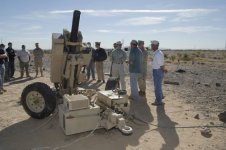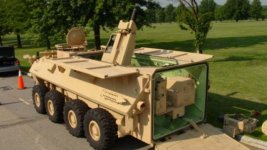Infanteer said:
I think you're right on that mark.
My biggest critique of the square combat team (the Square) is that it seems to run counter-intuitive to the notion of maximizing C2 nodes. Much of the study I've done suggests that smaller tactical organizations tend to fair better. For example, there is a good amount of literature on how a Squadron of four troops of 3 tanks performs better than a Squadron of three troops of four due to the extra C2 node (there is no increase in tanks, only one extra Troop Leader is added to the fray). The Square seems to run counter to this - putting in excess of 35 armoured fighting vehicles under a single sub-unit commander.
So yes, it's but one tool in the box, but have we made it the shiniest tool when it may not actually be a very practical one?
Let's take your hypothetical Armoured Regiment example - two tank squadrons and an infantry company, combined with a recce squadron. As opposed to having a Square plowing behind the Recce Squadron, would the CO be better served with two sub-units to manoeuvre behind the recce screen? Although the Sqn/Coy will occupy roughly the same ground, I suspect having both OCs pushing forces forward would be much more nimble than having one of the OCs plod forward with the whole shebang. One of the coolest exercises I saw was a BG Delay under a Armoured Regt HQ that had 2 Armoured Sqns and 2 Mech Coys. However, the desire to "go Square" meant that the Infantry OCs weren't doing much. I wonder if that limited what the BG could squeeze out of those resources.
Could make for an interesting bit of JCATS simulation - see what can be controlled by a BG Comd better and what is more responsive to changes on the battlefield. A 4 Tp + 3 Coy Square or a 2 Tp + 2 Coy and 2 Tp + 1 Pl Cbt Team bounding together.
Infanteer,
I am not a fan of the three-tank troop. I would rather have three troops of four than four troops of three. A troop of three that loses a single tank is not a fire team. I recognize that the Brits operate with troops of three tanks, and I imagine that their studies would support their doctrine.
The comparison of the efficiency of two small combat teams under the CO vs one square combat team is an excellent topic! I will cop out by saying that my answer would depend on the situation. I have taken both Canadian and US Army company command courses. A US Army Battalion Commander would likely form two company teams: one with two tank platoons and an infantry platoon and the other with one tank platoon and two infantry platoons. On my US Army course we would send the tank heavy team against an enemy infantry platoon in an VEE formation, the tanks leading with the infantry trailing centre and clearing the enemy. We in the Canadian army are very hesitant to grant equivalent combat power ratios between arms. We see an enemy platoon position and think that we need a company of infantry to clear them out regardless of how many tanks are shooting at the enemy positions. We might send an infantry platoon to clear a defile, but not an enemy platoon position. As an infantryman, would you be comfortable sending a combat team with two tank troops and a single infantry platoon to destroy an enemy platoon position? This is not a rhetorical question!
The US Army force of two company teams would be commanded by the CO or perhaps the S3 if it was on a secondary axis. We would have the two Majors (the OCs) commanding the force with one designated as the Combat Team Commander and other supporting. I think that we need to expand to the Battle Group level to see which one makes sense.
In the Canadian armoured BG example that I floated, it could absolutely be valid to form two combat teams and advance two-up. One team could be armour heavy (three Troops or maybe a two Troop Sqn (-) with a single infantry platoon and the other based on the infantry company with two platoons and a single tank Troop or a half-squadron. The CO would place himself somewhere to command both, keeping the second tank squadron in reserve to either exploit success or be the decisive effort in a meeting engagement. The two combat teams could support each other in an attack on an enemy platoon sized outpost - one in the firebase and the other assaulting. You'd have to sort out breaching assets ahead of time, and it might be awkward if you realize that you need the third platoon to deal with the enemy position. They would have a hard time supporting each other on the advance, though, as the combat team frontages make it hard to mutually support across the entire front. In addition, the troop leaders will lack SA on each other as they are not on an all-informed combat team net. They could each destroy enemy outposts, although the one with a single infantry platoon might have issues.
I agree that it would be fun to try out in simulation or on exercise!
The square combat team is well suited to advance "in space" and destroy enemy platoon sized security positions. The tank troops can support each other under the control of the OC and are all-informed. The infantry company is concentrated on the centre of the axis ready to destroy the enemy position. The Sqn OC can juggle tanks around to have ploughs in the right place. I am not saying that the square combat team is the only solution in this case, but I could understand why the CO would go with that grouping for this instance.
It does, though, look like the CO is washing his hands of the fight and leaving it to the two OCs to figure out. Perhaps lead with a sqn (-) with three troops and an infantry-heavy combat team following. The sqn (-) can advance with speed and aggression behind the recce squadron (or in front as the case may be), with the CO using the infantry combat team to destroy enemy outposts that cannot simply be bypassed. I could see this working.
For an attack on an integrated enemy company position by a BG, however, the square combat team can certainly create some issues. This situation, I think, calls for smaller combat teams task-organized for specific roles orchestrated and commanded by the CO.
As DS I suggest to my students that they solve tactical problems at the appropriate level. Some problems can be solved by a combat team commander, others need a battle group approach and other need a brigade solution. Speaking perhaps to your point on command, simply throwing addition assets without thinking about command is not a recipe for success.







